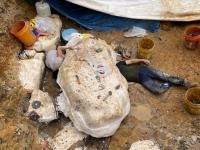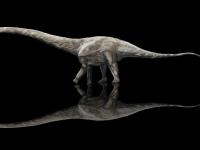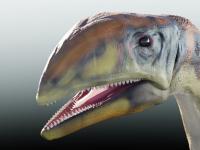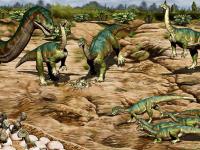Dinosaurs Were Warm-Blooded, Study of Fossil Eggshells Suggests

Using a novel technique called clumped isotope paleothermometry, an international team of paleontologists analyzed eggshell fossils representing three major dinosaur groups and found that these creatures were characterized by warm body temperatures.
“Dinosaurs sit at an evolutionary point between birds, which are warm-blooded, and reptiles, which are cold-blooded,” said Dr. Robin Dawson, a researcher in the Department of Geology and Geophysics at Yale University.
“Our results suggest that all major groups of dinosaurs had warmer body temperatures than their environment.”
Dr. Dawson and colleagues applied their novel method to the eggshells of three major groups of dinosaurs: Ornithischia, Sauropodomorpha, and Theropoda.
“Clumped isotope paleothermometry is based on the fact that the ordering of oxygen and carbon atoms in a fossil eggshell are determined by temperature,” they explained.
“Once you know the ordering of those atoms, you can calculate the mother dinosaur’s internal body temperature.”
“For example, eggshells of a Troodon, a small, meat-eating theropod, tested at 38 degrees, 27 degrees, and 28 degrees Celsius (or 100.4, 80.6, and 82.4 degrees Fahrenheit).”
“Eggshells from the large, duck-billed dinosaur Maiasaura yielded a temperature of 44 degrees Celsius (111.2 degrees Fahrenheit).”
“Both the Troodon and Maiasaura eggshells were from Alberta, Canada. Meanwhile, fossilized dinosaur eggs from the oospecies — a species classification limited to dinosaur eggs — Megaloolithus, from Romania, tested at 36 degrees Celsius (96.8 degrees Fahrenheit).”

The scientists conducted the same analysis on cold-blooded invertebrate shells in the same locations as the dinosaur eggshells.
This helped the team determine the temperature of the local environment — and whether dinosaur body temperatures were higher or lower.
“The Troodon samples were as much as 10 degrees Celsius (18 degrees Fahrenheit) warmer than their environment, the Maiasaura samples were 15 degrees Celsius warmer (27 degrees Fahrenheit), and the Megaloolithus samples were 3-6 degrees Celsius (5.4-10.8 degrees Fahrenheit) warmer,” Dr. Dawson said.
“What we found indicates that the ability to metabolically raise their temperatures above the environment was an early, evolved trait for dinosaurs.”
The results are published in the journal Science Advances.
_____
Robin R. Dawson et al. 2020. Eggshell geochemistry reveals ancestral metabolic thermoregulation in Dinosauria. Science Advances 6 (7): eaax9361; doi: 10.1126/sciadv.aax9361
Source: www.sci-news.com/








